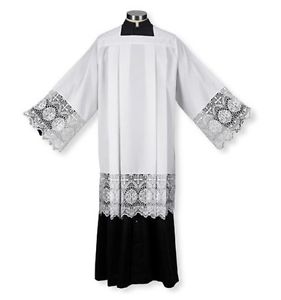

Q. 1. What is the Rochet and what is it used for?
A. 1. The rochet is a knee-length, white vestment worn over the choir cassock by bishops in choir. It is often, but not necessarily, very fancy with lace and linen. It is not interchangeable with the surplice, contrary to the belief of many bishops. It is distinct from the surplice not in the level of decoration, but in the sleeve: the sleeve of a rochet, like an alb, fits flush against the choir cassock; the sleeve of a surplice is fuller, and often bell-shaped.
The origin of the rochet may be traced from the clerical (non- liturgical) alba or camisia, that is, the clerical linen tunic of everyday life. It was thus not originally distinctive of the higher ecclesiastics alone. This camisia appears first in Rome as a privileged vestment; that this was the case in the Christian capital as early as the ninth century is established by the St. Gall catalogue of vestments. Outside of Rome the rochet remained to a great extent a vestment common to all clerics until the fourteenth century (and even longer); according to various German synodal statutes of the thirteenth and fourteenth centuries (Trier, Passau, Cambrai, etc.), it was worn even by sacristans. The Fourth Lateran Council prescribed its use for bishops who did not belong to a religious order, both in the church and on all public appearances. The name rochet (from the medieval roccus) was scarcely in use before the thirteenth century. It is first met outside of Rome, where, until the fifteenth century, the vestment was called camisia, alba romana, or succa (subta). These names gradually yielded to rochet in Rome also. Originally, the rochet reached, like the liturgical alb, to the feet, and, even in the fifteenth century still reached to the shins. It was not reduced to its present length until the seventeenth century.